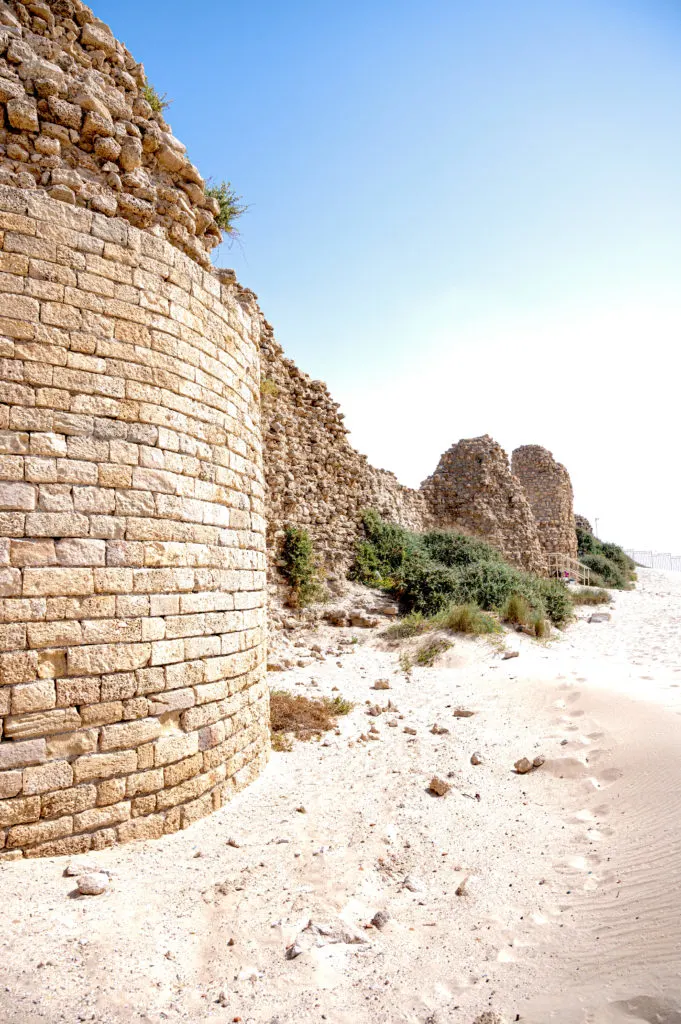Ashdod Yam is an archaeological site of the ancient city of Ashdod located within the modern city of Ashdod.
The most popular and fascinating thing to see in Ashdod Yam Ashdod Yam fortress which sits on the beach.
It especially nice to visit at the end of the summer when evening primrose flowers and beach lilies are in bloom.

History of Ashdod Yam and the Ashdod Yam Fortress
While today Ashdod Yam is located inside Ashdod, in ancient times they were two separate sister port cities.
Originally, Ashdod was a fortified Canaanite port city which was conquered Philistines.
Eventually it became one of the five most important Philistine city-states and was a thriving trade city.
However, when Ashdod was conquered by Assyrian in hopes to both gain military advantage and control the maritime trade of the Egyptians, Phoenicians, and the Land of Israel.
Under Assyrian control, Ashdod Yam was built near by with a smaller port as an administrative center. Also, exiles from other countries controlled by Assyria were brought to it.
Ashdod Yam developed into a major city
Ashdod revolted against Assyria with the support of Egypt and regained its independence as a city state. Ashdod Yam on the other hand remained an important city to the Assyrians.
In the following centuries, Ashdod was repeatedly conquered and destroyed by the Babylonians, Persians, Hellenists, and Hasmoneans.
By the Byzantine period, Ashdod-Yam had outgrown Ashdod who was now a mainland city rather than a costal one. Ashdod’s multiple destructions likely led to a gradual decline in its importance.
A diagram of Ashdod-Yam is shown in the Midba map depicting it as a large port city with a pier, houses, and many public buildings, including a fountain and churches.
There is evidence of a synagogue from the 6th century CE which testifies to the existence of a Jewish community at Ashdod Yam during the Byzantine period.
The Ashdod Yam Fortress
With the Arab conquest a large fortress was built on the ruins of the Byzantine settlement of Ashdod-Yam.
The fortress was part of a Umayyad costal defense system built to combat attacks of Christian forces to the west.
The system comprised a chain of strongholds built along the eastern Mediterranean coastline to warn of invading Byzantine ships.
In times of danger, massages were conveyed by means of beacons of fire (by night) and smoke signals (by day).
During the Fatimid dynasty, the fortress was fortified and expanded, and dubbed “Fortress of the Port.”
In 1033, the fortress was destroyed by an earthquake and abandoned.
It was reconstructed and resettled during the Crusader Period and its name was changed to Castellum Beroart.
It was abandoned once and for all after the Crusaders were banished from the country in 1290.
Excavation in the 1990s uncovered the ruins of the fortress. It revealed a rectangular structure with six round towers, two square towers, and two gates two gates.
There was an eastern land gate and a western sea gate.
The four gate tours and two corner towers facing the sea are round, while the two towers facing land are rectangular.
In the centerer of the fortress was a courtyard which was surrounded by domed rooms.
There is evidence of a moat which surrounded the citadel from the mainland and a bridge that led to the land gate.
Tourist Information
In 2020, the conservation project was completed and the fortress was officially opened to the public.
The works at the fort included strengthening the retaining walls laying down a floor and paving paths that make the fort accessible to visitors and people with disabilities.
Also, above the citadel structure, a thin “floating” terrace was erected overlooking the site and the beach.
Personally, I find all the modern additions distracting and remove part of the charm. However, while in my opinion it is not worth a special trip, it is a nice place to stop and explore if you are already in Ashdod.